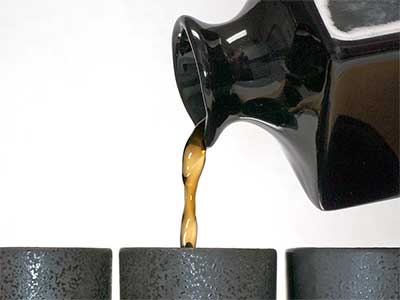March 9, 2015
Amuse-Bouche

thé aux champignons
(mushroom water)
Sometimes you don’t realize that your journey has come to an end until you’ve been at your final destination for a while. Plus, your final destination may not be where you intended to go when you started your journey. This happened to me recently, but before I tell you about it, let’s discuss mushroom essence.
The first, and practically the only time, I’ve run into mushroom essence in recipes is in Escoffier’s La Guide Culinaire, originally published in 1907. He uses mushroom essence as an ingredient in a number of dishes, but he never really describes how to make or acquire it. Escoffier provides only a general description for the preparation of essences with: “Elles ne sont rien autre chose que les fonds ordinaires, beaucoup moins mouillés que de coutume, afin d'assurer la concentration savorique de l'élément traité.” (They are made in the same way as ordinary stocks using much less liquid than usual so as to ensure that they have a concentrated flavor of the main ingredient.) He then goes on to give a detailed recipe for fish essence which is essentially a fumet de poisson (fish broth). He gives no recipe for mushroom essence.
The situation is slightly improved in the original, Prosper Montagne, 1938 version of the Larousse Gastronomique. Montagne provides a number of detailed recipes for the preparation of various essences, but his description for mushroom essence is still a bit sparse: “Essence de champignons. — N’est autre chose que la cuisson des champignons fortement réduite. S’emploie pour aromatiser les sauces.” (Essence of mushrooms. — This is merely the liquid, greatly concentrated, in which mushrooms have been cooked. It is used to flavor sauces.)
Later editions of the Larousse Gastronomique fail to illuminate mushroom essence until the Robuchon, French-language, millennium edition where a recipe is given: “Porter à ébullition dans une casserole 1⁄2 litre d’eau, 40 g de beurre, le jus de 1⁄2 citron et 6 g de sel. Mettre 50 g de champignons nettoyés dans ce mélange et cuire 10 min. Sortir les champignons. Faire réduire la cuisson de moitié et conserver l’essence au réfrigérateur.” (Add 1⁄2 liter of water, 40 g of butter, the juice from 1⁄2 lemon, and 6 g of salt to a saucepan. Bring to a boil. Add 50 g of cleaned mushrooms, and cook for 10 minutes. Remove the mushrooms. Reduce the cooking liquid by half, and store the essence in the refrigerator.) Unfortunately, I had already finished my journey when I found this recipe.
Back to my journey in search of mushroom essence. Which route should I take? At this point I had essentially no recipe. I could do as Escoffier and Montagne implied in their brief descriptions—I had worked with less information in the past—but that didn’t feel like the proper path to follow. The government tells me that the common, white mushroom contains just a bit more than 92% water. Could I somehow just extract this water? I envisioned the screen on my centrifugal juicer becoming instantly clogged, and I don’t have access to a masticating juicer. Juicing was out as an option. Could I puree the mushrooms in my Vitamix, and strain the puree? That seemed a bit too brutal. I imagined extracting the juice from the puree by squeezing it long and hard like when I milked almonds in 2003. I came up with and then discarded a number of other ideas. One morning, the possible solution became clear. Cook the mushrooms dry in an anaerobic container.
The next time I went to my local market that sells cheap mushrooms, I purchased 250 g (8-7⁄8 oz) of jumbo white mushrooms. (I’m told size doesn’t matter.) When I returned home I cleaned them, set up a water bath, sliced the mushrooms as thin as I could, and vacuum packed them. I cooked the bag of mushrooms with the water bath set to 88 °C (190 °F).
When I opened the lid to the water bath after 3 hours, I immediately saw that I had some success. There was significant liquid in the bag. I wondered how much. After removing the bag from the bath, I cut off a small portion of one corner and squeezed the liquid from the hot bag into a measuring class. I was amazed. I had managed to extract slightly more than half of the water from the mushrooms. I had 125 ml (4-1⁄4 fl oz) of brown, cloudy, mushroom-flavored liquid. It was quite tasty. I covered the top of the glass and set it in my refrigerator. I didn’t think I had come to the end of my journey quite yet.
Over the next few days, I figured out and then discarded a half dozen ways to use the mushroom liquid. I thought about clarifying it, but I didn’t want to loose any volume in the process. I even thought about separately distilling or centrifuging it. I thought about mixing the liquid with various gelling agents. I thought about flavoring a sauce with it. Then on another morning it came to me, I had finished my journey but I didn’t realize it. Why not just serve the liquid straight? Do nothing to it.
The main problem with serving the liquid as is was that its appearance was not particularly appetizing. It reminded me of the dark, cloudy water I see in drainage ditches after a storm, or worse. That problem was quickly resolved by pouring the mushroom liquid into a small cup with a black interior. In this cup, you couldn’t see the liquid!
To serve the mushroom liquid, I seasoned it with a little fine salt and reheated it in a microwave oven. The hot liquid was poured into a sake pitcher and presented on a tray with four black, 30-ml (1-fl oz) sake cups. A portion was poured for each guest with no explanation.
© 2015 Peter Hertzmann. All rights reserved.
